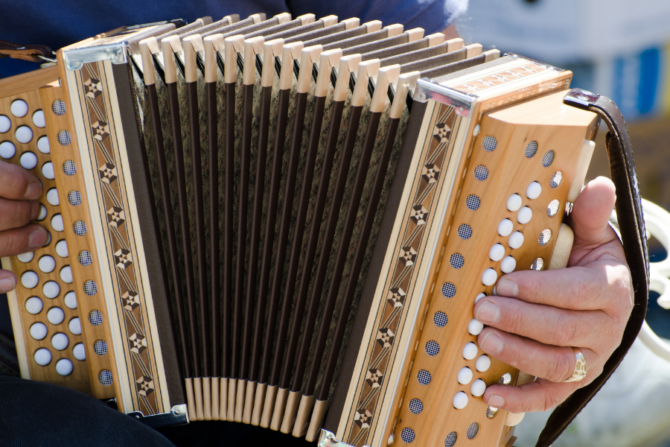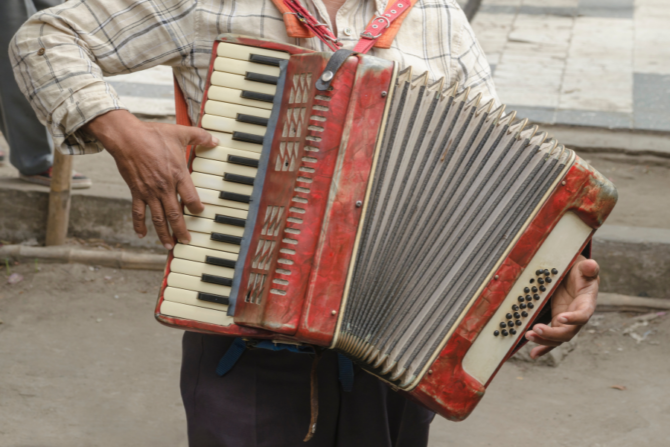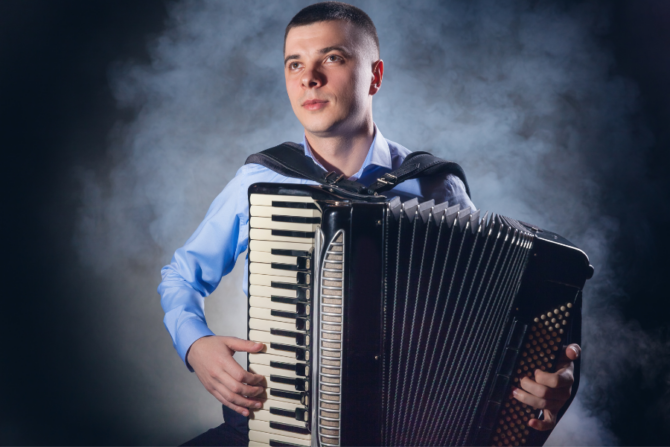The piano accordion is a type of free-reed aerophone instrument, that has been popular around the world since its invention in the early 19th century.
Its popularity comes from its versatile sound and range of tones, as well as its portability and relatively simple playing technique.
Table of Contents
- What Exactly Is A Piano Accordion?
- What Do We Know About The History Of The Piano Accordion?
- What Is The Difference Between A Piano Accordion And A Concertina?
- What Are The Different Types Of Piano Accordions?
- What Makes Up A Piano Accordion?
- Video: Learn The Major Parts Of The Piano Accordion
- Final Thoughts
With its ability to play both melody and chords simultaneously, the piano accordion is an excellent choice for both solo and ensemble performances.
What Exactly Is A Piano Accordion?
The piano accordion is a type of instrument that can be classified as either an aerophone or a chordophone. It has two manuals, the right-hand and the left-hand.
The Right Hand
The right-hand manual’s written range under scientific pitch notation is F3 to A6, with an actual sound range of F2 to A7 depending on the stops chosen.
There are piano accordions with up to 49 piano keys available (usually between 25 and 45 keys though), ranging from D3 to D7 in writing (D2 to D8 sounding), and some even feature a 32 ft stop for extended low range down to D1.
The Left Hand
On the other hand, the left-hand manual is usually designed as a bass/chord section. The basses generally cover one octave below middle C with each button controlling multiple notes which make chords like major and minor triads, along with seventh chords and others.
Both bass sections are often equipped with registers (bellows shake) operated by an extra button that adds or omits certain notes in order to create different sounds or textures for special effects such as vibrato or tremolo.
The instrument consists of bellows, buttons, keys, and an air chamber that allows the sound to be amplified or reduced.
What Do We Know About The History Of The Piano Accordion?
The history of the piano accordion is an interesting one. The first to feature a piano keyboard was probably the instrument introduced by Bouton of Paris, in roughly what we can estimate to be 1852.
Records from a few years later show that more piano-like instruments were built in Russia in 1871 by Nikolay Ivanovich Beloborodov, which indicates that the concept had expanded at least slightly throughout Europe.
In the United States, it was popularized particularly between 1900 and 1930 due to its familiarity with American teachers and students, as well as its uniformity across different immigrant groups.
Its popularization can largely be attributed to the fame of two Vaudeville entertainers, Guido Deiro and his brother Pietro, who were among some of the first to ever perform on an accordion using a piano keyboard layout.
Pietro Frosini also played a role in this wave of popularity after rearranging his buttons so that they resembled a piano keyboard more closely. Clearly, these influential players helped move the instrument into mainstream popularity just over 150 years ago!
What Is The Difference Between A Piano Accordion And A Concertina?
The concertina is a musical instrument that is most well known for its distinctive bellow sound. It originated in Europe and has since been adapted in various forms such as the Anglo-German, and English styles.
It can be constructed from any number of materials such as wood, plastic, or metal. In more recent concertinas, electronic components can also be used.
As with many musical instruments, the specific type of concertina determines how it is played; some require particular techniques such as rapid alternating bellows presses, while others need a player to learn specific fingering techniques.
Piano accordions are a type of button accordion and are made up of two banks of keys that both correspond to the same sound, whether played with the right or left hand.
The instrument has become very popular in different styles of music including folk music, tango, and others. The popularity of this instrument is seen in the fact that it can be found all over the world, including North and South America, Europe, Ireland, and Australia.
How Can You Learn To Play The Concertina?
For those interested in learning to play the concertina, each type requires different levels of expertise and familiarity with their respective fingering techniques.
Generally speaking, however, they all share a similar range of sounds that makes them an ideal choice for use in plays and other types of theatrical productions or special events where sound effects are needed.
What Are The Different Types Of Piano Accordions?
Button Accordion
The button accordion is a type of squeezebox instrument that most notably originated from Central and Eastern Europe, although it’s now used in many local styles of folk music around the world.

The trademark design of the classic button accordion features buttons arrayed in two rows on either side of the body – usually with one row devoted to single notes, known as a melodeon, and the other row used for bass and chord accompaniment.
Variations on this design are popular with different types of folk music, although each will leave from this basic layout slightly differently.
Piano Accordion
The piano accordion is widely credited to the Italian-American musician Guido Deiro. After adopting the German-made Hohner Panther model accordion in 1905 for his unique performing style in Vaudeville shows around America, he became immensely popular due to his showmanship and skill with the instrument.
His performances introduced both the instrument and its potential capabilities to audiences all over America at the time, which resulted in it becoming a phenomenon.
Today’s modern models have been refined after decades of performance innovation since then, making them an essential part of any modern musician’s arsenal.
Digital Accordion
The digital accordion has revolutionized the traditional squeezebox, bringing it up to date with the Information Age.
This modern version of the instrument retains all of its classic appeals, but now comes bundled with an array of onboard electronics, plus more advanced sound options and possibilities for MIDI compatibility.
With digital accordions, musicians are able to access a vast range of powerful effects such as reverb and chorus, allowing them to create fully custom soundscapes.
These instruments also have multiple voicing capabilities that can replicate everything from the beloved acoustic accordion timbre all the way through to rhythmically charged funk grooves.
Digital accordions are not only suitable for individual players, they’re great for jamming in groups as well. Their many new features make them much easier to use and control than their analog predecessors.
Onboard editing tools allow musicians to quickly make adjustments without ever having to take their hands off their instrument.
Finally, they offer unprecedented portability due to their lightweight and small size-making them ideal for traveling performers or those who need reliable standby instruments ready to go at a moment’s notice.
What Makes Up A Piano Accordion?
Bellows
The bellows are an integral component of most accordions, providing the primary means of articulation through motion.
Without the bellows, the instrument would have no sound and could not be played. It has been likened to a violin bow in terms of importance to producing sound, as well as to breathing for a singer.
Body
The accordion’s body is the foundation of its unique sound. It typically consists of two boxes, one for each hand, made from wood and fastened together by bellows. The boxes contain reed chambers, giving the accordion its distinctive sound.
At either end of the instrument are grilles, which are responsible for both circulating air and amplifying sound as it exits.
Generally speaking, the right-hand manual is used for playing the melody and the left-hand manual for accompaniment – though with some skill, players can switch these roles around to great effect.
The size and weight of an accordion will vary depending on its type and range. Regardless of the size or model though, whatever variation chosen, all accordions share this durable yet light body structure in common – culminating in a powerful yet sublime instrument that elicits captivating emotion through tone every time it is played.
Pallet Mechanism
The pallet mechanism is an important component of the accordion, as it controls the airflow of the instrument. It comprises a single button that can be pressed to activate multiple openings at once, allowing notes to sound simultaneously in a chord form.
This manual mechanism allows for great control over the sound of the accordion, as players can adjust the strength and length of each note depending on how many pallets are enabled at any one time.
The bass machine translates one button press into multiple pallet openings for a chord’s notes. This makes it easier for players to hit precise transitions between chords quickly and accurately – particularly useful when playing solo or alongside other instruments without accompaniment or percussion tracks.
It also opens up new possibilities for complex harmonic structures, allowing composers and performers to create music that could not be achieved using traditional techniques.
The versatility of this mechanism enables musical expression within accordions that would otherwise have been unavailable.
Video: Learn The Major Parts Of The Piano Accordion
Learn the major parts of the piano accordion in under 2 minutes in this excellent video from an accordion master:
Final Thoughts
The piano accordion is an incredibly versatile instrument that is capable of producing a wide range of sounds and textures. Its various components, including the bellows, body, and pallet mechanism, all come together to create the unique sound of this beloved instrument.
With its portability and easy adjustment tools, it’s no wonder why digital variants are becoming increasingly popular among both individual players and bands.
Whether you’re a beginner or a seasoned pro, the piano accordion is sure to bring joy and excitement to your playing.




